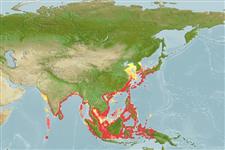Common names from other countries
Environment: milieu / climate zone / depth range / distribution range
Ecologia
; intervalo de profundidade 0 - 60 m (Ref. 275), usually 5 - 20 m (Ref. 275). Tropical; 41°N - 6°S, 69°E - 138°E (Ref. 1695)
Indo-West Pacific: Southern India to Japan and the Philippines.
Length at first maturity / Tamanho / Peso / Idade
Maturity: Lm 9.5, range 10 - 12 cm Max length : 23.0 cm ML macho/indeterminado; (Ref. 275); Peso máx. publicado: 1.3 kg (Ref. 1695)
Mantle about half as broad as long; tentacular club long, slender with 10-12 minute, subequal suckers in each row across the club in males, 13-14 suckers across in females, club protective membranes not united, extending proximally along oral face of stalk as lo ridges, Left arm IV hectocotylized: about 12 normal suckers (3 series) proximally followed by about 5 or 6 series of very small suckers in ventral longitudinal rows, corresponding suckers of dorsal longitudinal rows extremely minute (or absent) in a deep, smooth groove, suckers normal distally, Color: dorsal mantle with a fine, dark-pigmented, transverse, reticulate color pattern, a pale reflective line along bases of fins (Ref. 275).
Usually caught using otter trawls. Pair trawls are used for offshore fishing and smaller catches and to a lesser extent, squid light-lures and traps. Push nets and lift nets are used for inshore and coastal fishing (Ref. 346). Commercially caught from Gulf of Thailand and Andaman Sea (Ref. 1695).
Members of the class Cephalopoda are gonochoric. Male and female adults usually die shortly after spawning and brooding, respectively. Mating behavior: Males perform various displays to attract potential females for copulation. During copulation, male grasp the female and inserts the hectocotylus into the female's mantle cavity where fertilization usually occurs. Life cycle: Embryos hatch into planktonic stage and live for some time before they grow larger and take up a benthic existence as adults.
Jereb, P. and C.F.E. Roper (eds.). 2005. (Ref. 1695)
Status na Lista Vermelha da IUCN (Ref. 130435: Version 2024-1)
Status no CITES (Ref. 108899)
Not Evaluated
Not Evaluated
Uso pelos humanos
Pescarias: espécies comerciais
| FishSource |
Ferramentas
Fontes da internet
Estimates based on models
Preferred temperature
(Ref.
115969): 18.9 - 29.2, mean 28.5 (based on 728 cells).
Resiliência
Elevada, tempo mínimo de duplicação da população menor que 15 meses (K=0.4-1.49).
Vulnerabilidade
Low vulnerability (12 of 100).
